|
|
|
Sort Order |
|
|
|
Items / Page
|
|
|
|
|
|
|
| Srl | Item |
| 1 |
ID:
144221


|
|
|
|
|
| Summary/Abstract |
Contrary to the long-standing idea of a scientific failure in early modern China as compared to Europe, some recent work has emphasized the existence of a tradition of ‘evidential’ research in the natural sciences, antiquarianism, and geography, especially during the Sung, Ming, and Qing periods. This article seeks to develop this new perspective by offering a comparative history of the genres of travel writing and ethnography in early modern Europe and Ming/early Qing China. We argue that there were qualitative as well as quantitative differences in the way that these genres functioned in each cultural area. Even when we find apparent similarities, we note different chronological rhythms and a different position of these genres of travel writing within a wider cultural field—what we might term their ‘cultural relevance’. The specific nature of Chinese state imperialism—or, conversely, the particular nature of European overseas colonialism—played a role in determining the type of ethnographic approach that came to predominate in each cultural area. These parallels and differences suggest a fresh perspective on the cultural origins of the ‘great divergence’.
|
|
|
|
|
|
|
|
|
|
|
|
|
|
|
|
| 2 |
ID:
153011
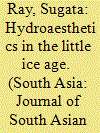

|
|
|
|
|
| Summary/Abstract |
Examining the visual tactics of framing flowing water in landscape painting and riparian architecture in Braj, a pilgrimage centre in North India where the god Krishna is believed to have spent his youth, the essay foregrounds a new conception of hydroaesthetics that emerged with the onset of the Little Ice Age (c. 1550–1850), a climatic period marked by catastrophic droughts and famines in South Asia. An engagement with the hydroaesthetics of beholding the river Yamuna's passage through Braj, the essay argues, brings to the forefront a reciprocal relationship between artistic practices based on a theological aesthetic of venerating the natural environment and ecological calamities. In doing so, the essay attempts to delineate a possible methodology for an ecological art history.
|
|
|
|
|
|
|
|
|
|
|
|
|
|
|
|
| 3 |
ID:
151284
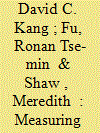

|
|
|
|
|
| Summary/Abstract |
How much war was there in early modern East Asia? This article empirically corroborates characterizations of relations between Sinic East Asian polities as being unusually peaceful and stable, which we attribute to the participants’ shared subscription to a common and accepted hierarchy framed by a Confucian worldview. More broadly, we provide direct empirical evidence that international hierarchies derive their stability from cultural consensus rather than simply asymmetries in material power. We make these claims by addressing the extent, range, and patterns of war in early modern East Asia by introducing and describing an extensive dataset of over 1,100 entries that measures war and other violence in early modern East Asia from 1368 to 1841 and relies principally on both Chinese and Korean language sources. The combination of these two Asian language sources forms the basis of a unique dataset that will substantially widen and complement the largely Chinese or English language sources that are generally used in debating war in early modern East Asia. Asia was composed of much more than simply China, and bringing in scholarship from other areas of early modern East Asia reflects a trend of moving past national studies to research the region more holistically.
|
|
|
|
|
|
|
|
|
|
|
|
|
|
|
|
| 4 |
ID:
191121
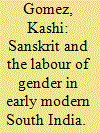

|
|
|
|
|
| Summary/Abstract |
In the early eighteenth century, a husband and co-wife trio undertook a household project in Maratha-ruled Tanjavur. These migrants from the Western Deccan jointly authored a set of Sanskrit commentaries invested in the idea of ‘Maharashtrianness’. The unusual authoring of a Sanskrit commentary by these women alongside their husband exemplifies broader changes that were taking place in Sanskrit intellectual circles in early modern South India. Tracing new formulations of regional identity, changing ideologies of gender, and shifts in the very labour of Sanskrit intellectual production, I demonstrate how new avenues of access to Sanskrit emerged for women in early modern South India. These new avenues of access were facilitated by the growing importance of the household as a site of cultural production and the rise of new regional courts in the Karnatak and Coromandel Coast regions.
|
|
|
|
|
|
|
|
|
|
|
|
|
|
|
|
| 5 |
ID:
159381
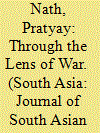

|
|
|
|
|
| Summary/Abstract |
The present article is a study of the process of Mughal empire-building in early modern North India using war as the point of entry. Specifically, it focuses on three sieges from the early years of Akbar's reign—Chitor (1567–68), Ranthambhor (1569) and Kalinjar (1569). It teases out certain aspects of these sieges and discusses them at length individually. Bypassing historiographically-popular themes like combat and technology, it explores less-probed issues such as the fate of defeated enemies, the involvement of zamindars and mansabdars, military finance and the role of quasi-military labour in imperial military campaigns. In the process, it strives to write a social, cultural and economic history of Mughal military expansion focused primarily on the second half of the sixteenth century.
|
|
|
|
|
|
|
|
|
|
|
|
|
|
|
|
| 6 |
ID:
137262
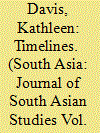

|
|
|
|
|
| Summary/Abstract |
This essay advances an argument regarding the structure of periodisation and the ways in which it limits critique of imperial historiography. It focuses first on the history and structure of medieval/modern periodisation and its relationship to the more recently popular ‘early modern’, and then turns briefly to the historiography of feudalism, an important anchor of the period concept, ‘the Middle Ages’. It then attends in more detail to the historiography of secularisation, particularly the recent tendency to find a secularising impulse in the texts of ‘early modern’ authors such as Vitoria and Grotius, which ultimately reinscribes the imperial logic that Subaltern Studies has worked to critique.
|
|
|
|
|
|
|
|
|
|
|
|
|
|
|
|
|
|
|
|
|